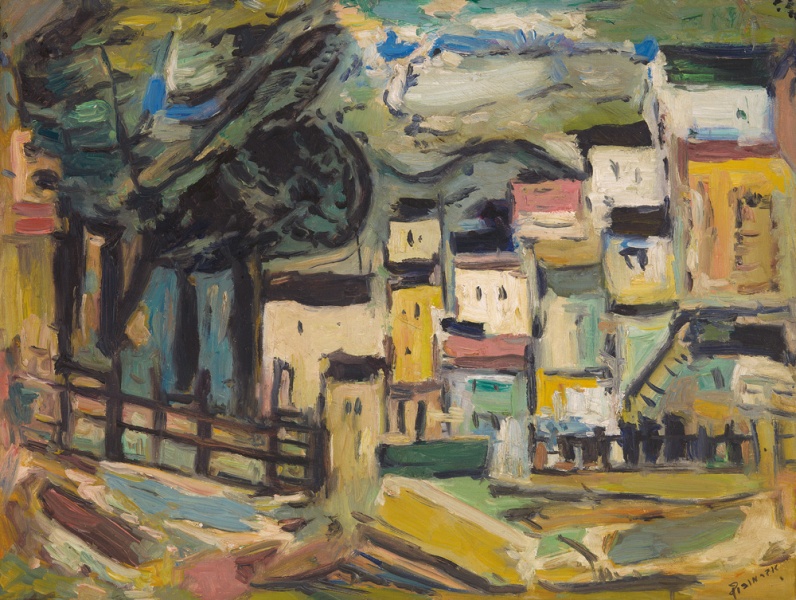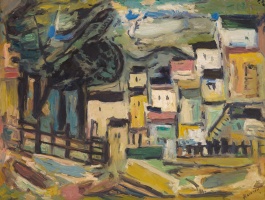
Abstract Landscape in Israel
| Author: | Pinchus Abramovich (1909–1986) |
Pinchus Abramovich was the youngest of eight children. Having joined the Zionist movement, he went to Palestine in 1929. He studied for two years in Tel Aviv under the Abstractionist Joseph Zaritsky from 1932, and continued his studies at the Académie de la Grande Chaumière in Paris in 1935 and 1936. Abramovich visited Lithuania in the autumn of 1935 and planned joint exhibitions of work by Palestinian and Lithuanian Jewish artists. During the Second World War, he served in the British army in Iraq and Iran. After the war, he helped found the Ofakim Hadashim (New Horizons) group, which was active in Israel from 1948 to 1963. Its artistic experimentation led to a new trend in lyrical Abstraction, which had a strong impact on the development of Israeli art. Abramovich held solo exhibitions, worked as an art teacher, and was twice elected head of the Association of Painters and Sculptors of Israel.
Source: Ellex Valiunas (LAWIN until 2015) art album: STORIES OF LITVAK ART (2023). Compiler and author Vilma Gradinskaitė.
Pinchas Abramovitch was one of the most prominent Israeli abstract artists. He was born in 1909 in Latvia. He started studying at Kaunas School of Art in 1925, and in 1929 he emigrated to Israel. He studied in Paris in 1935 and 1936 at the Académie de la Grande Chaumière. His work from the 1930s has features of Expressionism: dark colouring, flamboyant brushstrokes and lines, and an expressive distortion of shapes in the spirit of the Jewish School of Paris. While he was living in Israel, Abramovitch became famous as an abstract artist who appropriated the structure of geometric compositions of Iranian and Persian art. The geometric structures that appeared in his urban images around 1940 signified his growing tendency towards abstraction.
In 1948, Abramovitch founded the abstract art group New Horizons (Ofakim Hadashim). He participated in many exhibitions and biennales, both in Israel and abroad. He earned some important awards: Monaco (1966), Dizengoff (1968), Honorary Doctor of the Frankfurt Art Association (1985), and Honorary President of the Israeli Painting and Sculpture Association (1986). He died in 1986 in Israel.
Pinchas Abramovitch left for Israel in 1929 and never returned to Lithuania. He studied in Paris. At first, his pictures were distinguished by their dark colouring, like the works of other Jewish painters. He painted in colourful brushstrokes and lines, and expressively distorted shapes. Like other Jewish painters who lived in interwar Paris, Abramovitch was influenced by Expressionism, and later by Abstractionism. After his studies, Abramovitch returned to Israel and, under the influence of local traditions, he abandoned realistic imagery. Instead, he indulged his interest in the geometric structures of Iranian and Persian art, adopted their experience, and painted abstract pictures. To these he added cityscapes in which he emphasised the Cubist structure of buildings by impulsive, expressive and colourful brushstrokes.
Source: Valiunas Ellex (LAWIN until 2015) art album: THE WORLD OF LANDSCAPES II (2013). Compiler and author Nijolė Tumėnienė.

Pinchus Abramovich was the youngest of eight children. Having joined the Zionist movement, he went to Palestine in 1929. He studied for two years in Tel Aviv under the Abstractionist Joseph Zaritsky from 1932, and continued his studies at the Académie de la Grande Chaumière in Paris in 1935 and 1936. Abramovich visited Lithuania in the autumn of 1935 and planned joint exhibitions of work by Palestinian and Lithuanian Jewish artists. During the Second World War, he served in the British army in Iraq and Iran. After the war, he helped found the Ofakim Hadashim (New Horizons) group, which was active in Israel from 1948 to 1963. Its artistic experimentation led to a new trend in lyrical Abstraction, which had a strong impact on the development of Israeli art. Abramovich held solo exhibitions, worked as an art teacher, and was twice elected head of the Association of Painters and Sculptors of Israel.
Source: Ellex Valiunas (LAWIN until 2015) art album: STORIES OF LITVAK ART (2023). Compiler and author Vilma Gradinskaitė.
Pinchas Abramovitch was one of the most prominent Israeli abstract artists. He was born in 1909 in Latvia. He started studying at Kaunas School of Art in 1925, and in 1929 he emigrated to Israel. He studied in Paris in 1935 and 1936 at the Académie de la Grande Chaumière. His work from the 1930s has features of Expressionism: dark colouring, flamboyant brushstrokes and lines, and an expressive distortion of shapes in the spirit of the Jewish School of Paris. While he was living in Israel, Abramovitch became famous as an abstract artist who appropriated the structure of geometric compositions of Iranian and Persian art. The geometric structures that appeared in his urban images around 1940 signified his growing tendency towards abstraction.
In 1948, Abramovitch founded the abstract art group New Horizons (Ofakim Hadashim). He participated in many exhibitions and biennales, both in Israel and abroad. He earned some important awards: Monaco (1966), Dizengoff (1968), Honorary Doctor of the Frankfurt Art Association (1985), and Honorary President of the Israeli Painting and Sculpture Association (1986). He died in 1986 in Israel.
Pinchas Abramovitch left for Israel in 1929 and never returned to Lithuania. He studied in Paris. At first, his pictures were distinguished by their dark colouring, like the works of other Jewish painters. He painted in colourful brushstrokes and lines, and expressively distorted shapes. Like other Jewish painters who lived in interwar Paris, Abramovitch was influenced by Expressionism, and later by Abstractionism. After his studies, Abramovitch returned to Israel and, under the influence of local traditions, he abandoned realistic imagery. Instead, he indulged his interest in the geometric structures of Iranian and Persian art, adopted their experience, and painted abstract pictures. To these he added cityscapes in which he emphasised the Cubist structure of buildings by impulsive, expressive and colourful brushstrokes.
Source: Valiunas Ellex (LAWIN until 2015) art album: THE WORLD OF LANDSCAPES II (2013). Compiler and author Nijolė Tumėnienė.






